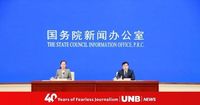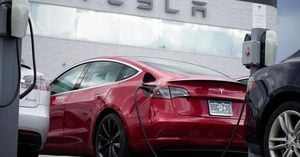Asia’s two economic giants, Japan and China, have managed to keep their growth engines humming through the first half of 2025, despite facing stiff headwinds from global trade tensions, domestic challenges, and shifting policy landscapes. Official data released Friday paints a nuanced picture: while Japan eked out modest gains in the face of punishing US tariffs, China’s economy continued to show remarkable resilience and vitality, buoyed by strong consumer demand and robust manufacturing output.
In Tokyo, the Cabinet Office reported that Japan’s gross domestic product (GDP) grew by 0.3 percent in the April-to-June quarter, handily beating market expectations of just 0.1 percent. On an annualized basis, that translates to a 1.0 percent expansion, compared to forecasts of 0.4 percent and following 0.6 percent growth in the previous quarter. This upward revision was especially significant: without it, Japan would have slipped into a technical recession, defined as two consecutive quarters of negative growth. As reported by BSS/AFP, the figures offered a much-needed boost for Prime Minister Shigeru Ishiba, whose political future has been shaky since his coalition lost its majority in July’s upper house elections amid widespread voter anger over the rising cost of living.
But the good news comes with plenty of caveats. Japan’s economy has been battered by tariffs imposed by US President Donald Trump, particularly a 27.5 percent levy on Japanese cars—a sector that employs eight percent of the nation’s workforce. Although Tokyo managed to negotiate a trade deal last month that slashed threatened 25 percent reciprocal tariffs on other goods to 15 percent, and car tariffs were also cut to 15 percent, the latter change had yet to take effect as of mid-August. The uncertainty is taking a toll on corporate Japan: Toyota slashed its annual net income forecast by 14 percent, warning of a $9.5 billion hit from tariffs in 2025. Honda saw its first-quarter profits halve, though it has since lowered its estimate of the tariff’s impact. Even electronics giant Sony has trimmed its forecast for tariff-related losses.
Economists are sounding the alarm about potential downside risks, especially for Japan’s export-driven economy. Yoshiki Shinke, chief economist at Dai-ichi Life Research Institute, cautioned that automakers “are expected to rethink their pricing strategies, and there is a possibility they may move to raise prices in the future.” He added, “In such a case, sales volumes in the US are likely to decrease, and export volumes could also be pressured downward.”
Meanwhile, the Trump administration is reportedly pressuring the Bank of Japan (BoJ) to hike interest rates, a move that could further dampen growth. US Treasury Secretary Scott Bessent told Bloomberg TV, “The Japanese have an inflation problem. They are behind the curve, so they are going to be hiking.” Experts believe this rhetoric is partly aimed at weakening the dollar and addressing rising yields on US long-term bonds. Marcel Thieliant, an economist at Capital Economics, predicted that despite the better-than-expected GDP figures, Japan’s growth will “slow a bit over the coming quarters.” He added, “With inflation set to remain far above the BoJ’s 2-percent target, we’re increasingly confident in our forecast that the Bank will resume its tightening cycle in October.”
Across the East China Sea, China’s economic narrative in July was one of steady progress and adaptability. According to the National Bureau of Statistics (NBS), industrial production rose 5.7 percent year on year in July, with high-tech manufacturing surging by 9.3 percent. Fixed-asset investment grew 1.6 percent in the first seven months of 2025, while retail sales of consumer goods climbed 4.8 percent and services expanded by 5.2 percent in the same period. Notably, retail sales of travel consulting, rental, transportation, cultural, sports, and leisure services all posted double-digit growth, reflecting a rebound in consumer confidence and pent-up demand.
Government policies to boost consumption—such as trade-in programs for consumer goods—have played a pivotal role. Among major retailers, sales of household appliances and audio-visual equipment soared by 28.7 percent year on year in July, and furniture sales jumped 20.6 percent. The appetite for upgraded lifestyles was also evident, with sports and entertainment goods up 13.7 percent and jewelry sales rising 8.2 percent. The production of new energy vehicles and industrial robots each surged 32.9 percent from January to July, while integrated circuits production increased by 10.4 percent, underscoring the momentum in emerging sectors.
Despite ongoing global uncertainties, China’s foreign trade remained robust. Total goods imports and exports in yuan-denominated terms grew by 6.7 percent in July, accelerating from June’s pace by 1.5 percentage points. NBS spokesperson Fu Linghui attributed this resilience to China’s deepening trade cooperation with partners worldwide and the competitiveness of its products. Fu told the press that “the resilience and strengths of China’s foreign trade lie in the country’s ever-deepening trade cooperation with countries across the world, as well as its highly competitive products and the vitality of foreign trade firms.”
On the jobs front, China’s surveyed urban unemployment rate edged up to 5.2 percent in July—a seasonal increase of 0.2 percentage points, largely attributed to the graduation season—but remained well within the annual ceiling of 5.5 percent. The unemployment rate for rural migrant workers stood at 4.9 percent, below the national urban average, signaling relative stability among key labor groups. Still, Fu Linghui was quick to caution that the “foundation for economic recovery and improvement still needs to be consolidated,” citing external instabilities, domestic supply-demand imbalances, and emerging structural issues.
Looking ahead, China has set its full-year economic growth target at around 5 percent. In the first half of 2025, GDP grew 5.3 percent year on year, putting the target well within reach. Jens Eskelund, president of the European Union Chamber of Commerce in China, expressed optimism: “It is encouraging to see that the rate of consumption in China is increasing. A number of consumer-facing segments in China’s economy are relatively nascent and have huge growth potential.”
Both Japan and China are navigating a world marked by trade protectionism, shifting consumer trends, and the lingering effects of global disruptions. For Japan, the challenge remains how to sustain growth amid external shocks and domestic political uncertainty. For China, the focus is on consolidating the gains made through policy stimulus, fostering new growth drivers, and keeping employment and expectations stable as the country pushes toward its ambitious targets.
As the second half of 2025 unfolds, the fortunes of these two Asian powerhouses will be closely watched—not just by their own citizens and businesses, but by a world that depends on their stability and dynamism. Whether they can maintain momentum in the face of persistent headwinds will shape the broader trajectory of the global economy in the months to come.




